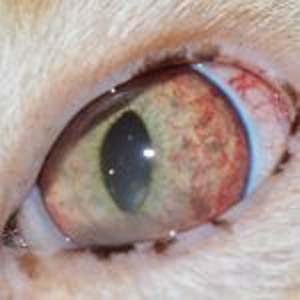Pet Uveitis (Inflammation) Spring, TX
Uveitis is an eye ailment that affects cats and dogs. It can be brought on by underlying medical conditions that affect the eye or other parts of the body.

What is Uveitis?
Uveitis is inflammation of the uvea, which is made up of three parts: the iris, the ciliary body, and the choroid. One or all of these ocular structures can be inflamed, causing inflammation inside the eye. The iris is the colored part of the eye and is clearly visible to the “naked eye.” The ciliary body and choroid sit behind the iris and pupil, so special instruments are required to view these structures. It is more common to have anterior Uveitis, which affects the iris and ciliary body.
In the normal eye, there is a barrier between the fluid inside the eye (aqueous) and the blood vessels that supply the eye, which prevents large molecular weight proteins and cells from entering the eye. However, this barrier is disrupted with Uveitis, allowing inflammatory cells, proteins, and other blood components to leak into the eye.
What are the clinical signs of Uveitis?
Due to the inflammation of one or all parts of the uvea (iris, ciliary body, and/or choroid), there is a disruption of the normal barrier that protects the eye. Symptoms may include redness, squinting, rubbing, light sensitivity (photophobia), ocular discharge, pupil asymmetry (due to the pupil in the affected eye being smaller- termed miosis), cloudiness, and occasionally blood in the eye (termed hyphema), and in some cases, vision loss.
What causes Uveitis?
Uveitis can be caused by anything that causes disruption of the normal blood-aqueous barrier. Many different conditions, including trauma, corneal ulcerations, infectious diseases, vascular disease (i.e., systemic hypertension), fungal diseases, cancer, autoimmune diseases, or cataracts, can result in Uveitis.
What is the treatment for Uveitis?
At North Houston Veterinary Ophthalmology, diagnosis of the underlying cause is ideal when Uveitis is present. Sometimes this can be accomplished by performing an exam alone, such as when corneal ulceration is present. Other times, additional blood tests are required to look for signs of infectious disease or certain cancers. In some cases, an underlying cause cannot be identified (termed idiopathic). Treatment of Uveitis varies based on the clinical signs and the disease process identified. Treatment can involve topical and/or oral antibiotics, topical and/or oral steroids, topical and/ or oral non-steroidal anti-inflammatories (NSAIDs), and possibly a dilating agent. The goal of treatment is to re-establish the normal blood-aqueous barrier. In some cases, treatment needs to be continued life-long.
